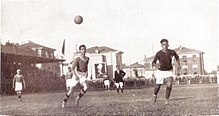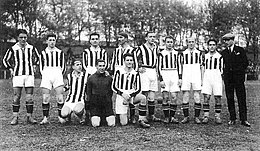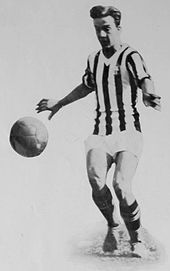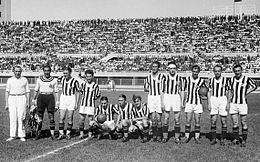23 - 1923/1924 - a narrower tournament in the North and a larger in the South
Scudetto introduction
To sanction the newfound peace, the Federation devised the Scudetto, a symbol for the reigning Italian champions. The introduction of such a patch also had an ulterior motive: with the official symbolism of the cloth triangle, which would later become for all fans the tangible symbol of national supremacy, from then on, nobody else than the FIGC would be able to confer value on an alternative title to the federal one.
The road to the new Championship - Northern League events
The new 1923-1924 season began with some clubs' fusions. In Verona, the total black Bentegodi Verona, which played the First Division the previous year, merged into Hellas Verona, a more financially solid club.
Moreover, US Milanese acquired the remnants of Internazionale Milano, with an agreement between Luigi Bosisio (ex-Milan and Internazionale) for USM and Arturo Hintermann, Internazionale's president. Internazionale disappeared from the league tables, with its first team becoming the Reserve team of USM. The reason underlying the merger was linked to the will to compete and quash the dominance of Milan in the city. Moreso, to create a more appealing image for the club and the desire to represent the whole city of Milan brought the new name Unione Sportiva Ambrosiana. Paying homage to Internazionale, the third kit of the new club became the black and sky blue diagonal stripe on a white shirt. The Checkers instead remained the first and second kits.
Additional changes in the forecasted structure of the Northern League were the forfeits of Speranza Savona and Derthona; both clubs didn't meet the financial obligations for the tournament. Brescia and Novara applied for the repechage, leading to their readmission to the First Division. SC Italia tried to participate in the championship, but the flight of players towards Ambrosiana (since a significant part of the management moved to the new team) plagued the club, leading to its enrollment in Third Division. Therefore the last berth in First Division North went to Cremonese, who triumphed in the Second Division playoffs the previous year and joined the ranks.
The road to the new Championship - Southern League events
The Southern tournament returned to a regional eliminatory perspective despite the FIGC's strongly recommended against it. This measure arrived because of the intense lobbying of Roman, Palermo, and Internapoli (the new name of the previous Internazionale Napoli), all excluded by the cut to 12 teams. The structure of the Southern League included the following:
Eliminatory phase
Semifinals: First two clubs of Qualification phase Round A & Round B
Finals
Northern League - First Division Round A:
As usual, the start of the new season also saw Genoa, the leading team in early Italian soccer and the defending champions, as the top-ranked team. The Rossoblù got a strong start, smashing six goals against Casale. Genoa lost its first time on the sixth day, after thirty-three consecutive days of unbeaten streak, a record that would remain unbroken for 69 years.
The Grifoni soon recovered, but giving them a hard time was Juventus: Edoardo Agnelli had become president of the Bianconeri club and had immediately begun an aggressive strengthening campaign conducted to the tune of thousands of Lire (although federal statutes still forbade professionalism, the practice of paying athletes under the table was widespread). Juventus won in the direct clash in Turin, bringing them to within one point of each other; at the end of the first half of the season, the Bianconeri and Genoans were at the top on 16 points, two points below Alessandria and Venezia: Juventus' encouraging results, however, were shortly afterward annulled by sports justice.
Compromising the scudetto race of Agnelli's club was, in fact, the controversial signing of Bianconeri full-back Virginio Rosetta, previously with Pro Vercelli. At the beginning of the season, Rosetta and his teammate Gustavo Gay sent a letter of resignation to Luigi Bozino, president of the Vercelli club, who accepted. Gay and Rosetta, now free agents, elected to move to Milan (Gay) and Juventus (Rosetta).
On October 24th, the Northern League, headed by Rossoneri manager Ulisse Baruffini, approved Gay's move to Milan; however, when Rosetta asked for his inclusion into the transfer list on November 7th, 1923, Baruffini postponed any decision to the League Council on December 1st. Rosetta then filed a complaint with the FIGC, which upheld it on November 24th, 1923, ruling that all players that had their resignation accepted by their home club were automatically free transfers.
The Bianconeri, on the strength of the Federation's resolution, fielded Rosetta against Modena, Genoa, and Padova, winning all three matches; the three beaten clubs appealed for Rosetta's irregular position, and the Northern League ruled in their favor, automatically awarding each team a 2-0 victory. At the same time, Juventus vice-president Craveri filed a complaint about the forfeited defeats with the Federal Council, which on December 15th ruled in Juventus' favor, giving them back their three victories in the incriminated matches.
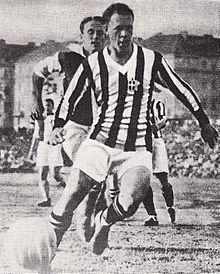
The tug-of-war between the FIGC and the Northern League continued for almost two months, alarming the CONI, ruled by Aldo Finzi, who decided to intervene to avert a new schism after one of 1921 and to prevent the national team's performance at the upcoming Olympics from being compromised: the CONI, therefore, issued an agenda in which it pronounced itself favorable to the Northern League's positions. The case was closed at the general assembly of February 9th, 1924, when the federated clubs, agreeing with the Northern League, challenged the federal council and forced it to resign. The FIGC was then commissioned and ruled on February 17th that Rosetta should still be considered a Pro Vercelli player and that, since his player's card had been revoked, he could no longer play for the rest of the season; the FIGC itself awarded a forfeit to Juventus in the three matches they won on the field against Modena, Genoa, and Padova, but pardoned the Bianconeri for the next four games in which Rosetta participated, because they occurred after the December 15th ruling (Juventus' opponents had not appealed in this case) and because of the good faith of Agnelli's club. At the end of the season, the Torinese paid 50,000 lire to Pro Vercelli, and Rosetta (in the picture on the right) passed permanently to the Bianconeri.
The result of the Rosetta affair was that Juventus found itself cut out of the title race. On the eve of the final ruling, on the fifteenth day (played on February 10th, 1924), the Bianconeri and the Genoans were paired at the top on 21 points, trailing Venezia by two lengths. A defeat in Novara the following day, combined with the ruling, caused Juventus to slip to seventh place in the standings, ten points off the top. Despite a drop in the final, Genoa managed the wide gap over Padova, Ambrosiana, and Venezia and qualified for the final. However, to underscore the importance of the Rosetta Case on the fate of the championship, in the hypothetical final ranking compiled without taking into account the February 17th ruling, the Bianconeri would be at the top of the round with a one-point advantage over the Grifone, although it cannot be excluded that the sentence may have affected the performance of both teams (with Genoa now sure of first place and Juventus in mid-table with no more goals they may have lost points because demotivation) and therefore, there can be no absolute certainty as to which of the two teams would win the round.

Northern League - First Division Round B:
In contrast, the other grouping experienced a head-to-head between Bologna, Torino, and Pro Vercelli. Torino jumped ahead at the start of the championship, while Bologna had a shaky start (5 points in the first five days).
Three consecutive defeats plagued the Torinese Black and Yellow between the seventh and ninth day, allowing the white lions of Vercelli to end the first half of the season at the top with a one-length lead over Torino and Mantova and three over Bologna, Legnano, and Andrea Doria.
On the fourteenth day, however, Pro Vercelli lost on the field of Hellas Verona, suffering the overtaking at the top by Torino (which had played one more game). Pro Vercelli had a decline at this point and, due to three draws in the next four games, suffered Bologna's overtake just on the eve of the direct clash. On the third last day, Bologna stormed Pro Vercelli's field (unbeaten in league matches since 1915), distancing the Lion Whites to three points with only two games left.
On the following day, while Vercelli suffered another defeat, abdicating any hopes of a comeback, Bologna, victorious on the Andrea Doria pitch, overtook Torino at the top, defeated amidst controversy 1-0 at US Triestina's, battling into the relegation zone, in a match that suffered numerous stoppages of play due to the unsportsmanlike behavior of the home crowd. On the last day, Torino won the direct clash against Bologna. The Black and Yellow victory wasn't enough since Bologna won the recovery game against Hellas Verona, winning First Division B Round.
Torino made, then, a complaint to obtain a victory as by official rule in the match against US Triestina due to the intemperance of the opposing fans, and consequently the first place in the round at the expense of Bologna: the Federal Presidency, however, rejected on May 17th the request of the Piedmontese, confirming the results of the field.

Northern Final
The two red and blue teams faced each other for the Northern League final on June 15th, 1924, after a break that lasted all of May for the national team's participation in the 1924 Paris Olympics, on the Genoa field on Via del Piano in Marassi.
The match was very nervous on and off the field, with brawls among spectators and pitch invasions. One of the invaders was the former Genoa player and current coach of Cremonese, Giovanni Battista Traverso, that hit Bologna's player Giuseppe Della Valle, with a fist. The match was resolved in favor of the hosts only in the final, thanks to a goal by Neri, despite the evident supremacy of play by Bologna. Bologna later complained about the homologation of the result, rejected by the Northern League directorate on June 22nd; Genoa was fined 1,000 lire for the pitch invasion, while coach Traverso received a four months disqualification.
The return match happened in Emilia a week later on the Sterlino field hit by relentless rain. Bologna, like in the first leg match, maintained a clear dominance of the
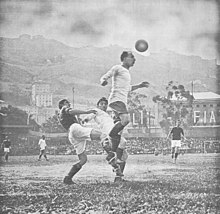 game, but Genoa responded promptly on the pitch in the first half with a counterattack goal by Santamaria. The score sent the Bologna crowd into a state of despair. In the first quarter of an hour of the second half, Bologna managed to equalize with a penalty converted by Pozzi, and in the next thirty minutes, the match dragged on convulsively, ravaged by both the downpour and the turbulent behavior of the fans, to the point that referee Panzeri of Milan got out of hand (a chronicle of the next day would call him a "shipwreck in a storm").
game, but Genoa responded promptly on the pitch in the first half with a counterattack goal by Santamaria. The score sent the Bologna crowd into a state of despair. In the first quarter of an hour of the second half, Bologna managed to equalize with a penalty converted by Pozzi, and in the next thirty minutes, the match dragged on convulsively, ravaged by both the downpour and the turbulent behavior of the fans, to the point that referee Panzeri of Milan got out of hand (a chronicle of the next day would call him a "shipwreck in a storm").
The match was suspended a few minutes before its closure, after some Bologna supporters had attempted another pitch invasion, climbing over the fence nets. At first, the match director justified the decision based on the impracticability of the field due to bad weather conditions but then confided to reporters that he had taken such a measure due to the intemperance of the home fans and that he had awarded the penalty kick for the equalizer only after heavy pressure (in the match report, he explained verbatim that he had "speciously awarded the penalty kick to Bologna to avoid incidents on the field and in the stands").
The Northern League homologated the result (despite Genoa's complaint) and reserved its decision after questioning the match director. After Panzeri's interrogation, the Northern League decided prosaically to homologate the result, since also in Genoa the spectators invaded the pitch, and to fine Bologna for 1,000 lire. The Ligurians, having thus won the Northern League title, faced Alba Roma in the final in September after a long wait due to the protracted southern championship.

Southern League
Regional Elimination Rounds
After debated and controversial qualification rounds, in the July 27th first-leg final, Savoia was imposing itself on the Alba field by 2-0 when referee Grossi whistled the end of the match five minutes early. The pitch was immediately invaded by Alba Roma fans who threatened the referee (guilty of having awarded a penalty to Savoia for a possibly unintentional hand foul), urging the Regi Carabinieri to intervene; in the meantime, Grossi, immediately noticing the error on the linesmen's signal, tried to get the teams back on the field to end the challenge without founding Alba players, who had already hastily left the Stadium before the news could
 reach them.
reach them.
The Southern League upheld the Alba complaint by canceling the match because the referee ended it too early, electing for the repeat as a return match. Meanwhile, the following week, Savoia again imposed itself on its opponents 2-0, this time in Torre Annunziata. In the repetition of the first leg match, held on August 10th, however, the Romans prevailed 1-0, thus tying the series, making it necessary to play a knock-off on a neutral field.
However, Savoia filed a complaint contesting the cancellation of the July 27th match. The Federal Council was supposed to decide on the appeal at the assembly in Turin on August 24th. The absence of the president of the Southern League and the non-arrival from Rome of documents in the League's possession made any decision on the matter impossible.
In the meantime, the Southern League required Alba and Savoia to travel to Livorno on August 24th anyway to play the knock-off to prevent yet another complaint by the Savoia from leading to the loss of additional Sundays, not to mention that Genoa was pushing to play the final as soon as possible. The Romans traveled to Livorno, where the Whites of Savoia arrived two days earlier and indulged in the nightlife, as the nasty gossips say. Alba smashed Savoia 4-1 with the scores of Degni (2x), Caimmi, and Rovida. Savoia's goal was from Bobbio. (in the picture Degni, scorer in previous finals for Fortitudo Roma).
National Final
The final came for the Rossoblù after a two-month summer break. In the first leg, in Genoa, Genoa immediately took a two-goal lead in the first quarter of an hour of the match, Alba Roma did not give up and shortened the gap in the 49th minute with Degni. In the 55' Genoa scored with Santamaria the 3-1 goal, the result with which the match ended.
The return match at the Stadio Nazionale in Rome on September 7th, 1924 was balanced: the first half ended 0-0. In the second half, Genoa took the lead with an alleged phantom goal by Moruzzi in the 71st minute. Two minutes after, Alba Roma regained the draw with Lo Prete. The contest ended 1-1, and thanks to the 3-1 victory in the first leg, Genoa won its ninth Scudetto.

Roll of Honor

To sanction the newfound peace, the Federation devised the Scudetto, a symbol for the reigning Italian champions. The introduction of such a patch also had an ulterior motive: with the official symbolism of the cloth triangle, which would later become for all fans the tangible symbol of national supremacy, from then on, nobody else than the FIGC would be able to confer value on an alternative title to the federal one.
The road to the new Championship - Northern League events
The new 1923-1924 season began with some clubs' fusions. In Verona, the total black Bentegodi Verona, which played the First Division the previous year, merged into Hellas Verona, a more financially solid club.
Moreover, US Milanese acquired the remnants of Internazionale Milano, with an agreement between Luigi Bosisio (ex-Milan and Internazionale) for USM and Arturo Hintermann, Internazionale's president. Internazionale disappeared from the league tables, with its first team becoming the Reserve team of USM. The reason underlying the merger was linked to the will to compete and quash the dominance of Milan in the city. Moreso, to create a more appealing image for the club and the desire to represent the whole city of Milan brought the new name Unione Sportiva Ambrosiana. Paying homage to Internazionale, the third kit of the new club became the black and sky blue diagonal stripe on a white shirt. The Checkers instead remained the first and second kits.
Additional changes in the forecasted structure of the Northern League were the forfeits of Speranza Savona and Derthona; both clubs didn't meet the financial obligations for the tournament. Brescia and Novara applied for the repechage, leading to their readmission to the First Division. SC Italia tried to participate in the championship, but the flight of players towards Ambrosiana (since a significant part of the management moved to the new team) plagued the club, leading to its enrollment in Third Division. Therefore the last berth in First Division North went to Cremonese, who triumphed in the Second Division playoffs the previous year and joined the ranks.
The road to the new Championship - Southern League events
The Southern tournament returned to a regional eliminatory perspective despite the FIGC's strongly recommended against it. This measure arrived because of the intense lobbying of Roman, Palermo, and Internapoli (the new name of the previous Internazionale Napoli), all excluded by the cut to 12 teams. The structure of the Southern League included the following:
Eliminatory phase
- Tuscan: Round A & Round B
- Central: Round A
- Latium: Round A, Round B & Round C
- Campania: Round A & Round B
- Apulian: Round A
- Islands: Round A & Round B, with playoff
Semifinals: First two clubs of Qualification phase Round A & Round B
Finals
Northern League - First Division Round A:
As usual, the start of the new season also saw Genoa, the leading team in early Italian soccer and the defending champions, as the top-ranked team. The Rossoblù got a strong start, smashing six goals against Casale. Genoa lost its first time on the sixth day, after thirty-three consecutive days of unbeaten streak, a record that would remain unbroken for 69 years.
The Grifoni soon recovered, but giving them a hard time was Juventus: Edoardo Agnelli had become president of the Bianconeri club and had immediately begun an aggressive strengthening campaign conducted to the tune of thousands of Lire (although federal statutes still forbade professionalism, the practice of paying athletes under the table was widespread). Juventus won in the direct clash in Turin, bringing them to within one point of each other; at the end of the first half of the season, the Bianconeri and Genoans were at the top on 16 points, two points below Alessandria and Venezia: Juventus' encouraging results, however, were shortly afterward annulled by sports justice.
Compromising the scudetto race of Agnelli's club was, in fact, the controversial signing of Bianconeri full-back Virginio Rosetta, previously with Pro Vercelli. At the beginning of the season, Rosetta and his teammate Gustavo Gay sent a letter of resignation to Luigi Bozino, president of the Vercelli club, who accepted. Gay and Rosetta, now free agents, elected to move to Milan (Gay) and Juventus (Rosetta).
On October 24th, the Northern League, headed by Rossoneri manager Ulisse Baruffini, approved Gay's move to Milan; however, when Rosetta asked for his inclusion into the transfer list on November 7th, 1923, Baruffini postponed any decision to the League Council on December 1st. Rosetta then filed a complaint with the FIGC, which upheld it on November 24th, 1923, ruling that all players that had their resignation accepted by their home club were automatically free transfers.
The Bianconeri, on the strength of the Federation's resolution, fielded Rosetta against Modena, Genoa, and Padova, winning all three matches; the three beaten clubs appealed for Rosetta's irregular position, and the Northern League ruled in their favor, automatically awarding each team a 2-0 victory. At the same time, Juventus vice-president Craveri filed a complaint about the forfeited defeats with the Federal Council, which on December 15th ruled in Juventus' favor, giving them back their three victories in the incriminated matches.

The tug-of-war between the FIGC and the Northern League continued for almost two months, alarming the CONI, ruled by Aldo Finzi, who decided to intervene to avert a new schism after one of 1921 and to prevent the national team's performance at the upcoming Olympics from being compromised: the CONI, therefore, issued an agenda in which it pronounced itself favorable to the Northern League's positions. The case was closed at the general assembly of February 9th, 1924, when the federated clubs, agreeing with the Northern League, challenged the federal council and forced it to resign. The FIGC was then commissioned and ruled on February 17th that Rosetta should still be considered a Pro Vercelli player and that, since his player's card had been revoked, he could no longer play for the rest of the season; the FIGC itself awarded a forfeit to Juventus in the three matches they won on the field against Modena, Genoa, and Padova, but pardoned the Bianconeri for the next four games in which Rosetta participated, because they occurred after the December 15th ruling (Juventus' opponents had not appealed in this case) and because of the good faith of Agnelli's club. At the end of the season, the Torinese paid 50,000 lire to Pro Vercelli, and Rosetta (in the picture on the right) passed permanently to the Bianconeri.
The result of the Rosetta affair was that Juventus found itself cut out of the title race. On the eve of the final ruling, on the fifteenth day (played on February 10th, 1924), the Bianconeri and the Genoans were paired at the top on 21 points, trailing Venezia by two lengths. A defeat in Novara the following day, combined with the ruling, caused Juventus to slip to seventh place in the standings, ten points off the top. Despite a drop in the final, Genoa managed the wide gap over Padova, Ambrosiana, and Venezia and qualified for the final. However, to underscore the importance of the Rosetta Case on the fate of the championship, in the hypothetical final ranking compiled without taking into account the February 17th ruling, the Bianconeri would be at the top of the round with a one-point advantage over the Grifone, although it cannot be excluded that the sentence may have affected the performance of both teams (with Genoa now sure of first place and Juventus in mid-table with no more goals they may have lost points because demotivation) and therefore, there can be no absolute certainty as to which of the two teams would win the round.
Northern League - First Division Round B:
In contrast, the other grouping experienced a head-to-head between Bologna, Torino, and Pro Vercelli. Torino jumped ahead at the start of the championship, while Bologna had a shaky start (5 points in the first five days).
Three consecutive defeats plagued the Torinese Black and Yellow between the seventh and ninth day, allowing the white lions of Vercelli to end the first half of the season at the top with a one-length lead over Torino and Mantova and three over Bologna, Legnano, and Andrea Doria.
On the fourteenth day, however, Pro Vercelli lost on the field of Hellas Verona, suffering the overtaking at the top by Torino (which had played one more game). Pro Vercelli had a decline at this point and, due to three draws in the next four games, suffered Bologna's overtake just on the eve of the direct clash. On the third last day, Bologna stormed Pro Vercelli's field (unbeaten in league matches since 1915), distancing the Lion Whites to three points with only two games left.
On the following day, while Vercelli suffered another defeat, abdicating any hopes of a comeback, Bologna, victorious on the Andrea Doria pitch, overtook Torino at the top, defeated amidst controversy 1-0 at US Triestina's, battling into the relegation zone, in a match that suffered numerous stoppages of play due to the unsportsmanlike behavior of the home crowd. On the last day, Torino won the direct clash against Bologna. The Black and Yellow victory wasn't enough since Bologna won the recovery game against Hellas Verona, winning First Division B Round.
Torino made, then, a complaint to obtain a victory as by official rule in the match against US Triestina due to the intemperance of the opposing fans, and consequently the first place in the round at the expense of Bologna: the Federal Presidency, however, rejected on May 17th the request of the Piedmontese, confirming the results of the field.
Northern Final
The two red and blue teams faced each other for the Northern League final on June 15th, 1924, after a break that lasted all of May for the national team's participation in the 1924 Paris Olympics, on the Genoa field on Via del Piano in Marassi.
The match was very nervous on and off the field, with brawls among spectators and pitch invasions. One of the invaders was the former Genoa player and current coach of Cremonese, Giovanni Battista Traverso, that hit Bologna's player Giuseppe Della Valle, with a fist. The match was resolved in favor of the hosts only in the final, thanks to a goal by Neri, despite the evident supremacy of play by Bologna. Bologna later complained about the homologation of the result, rejected by the Northern League directorate on June 22nd; Genoa was fined 1,000 lire for the pitch invasion, while coach Traverso received a four months disqualification.
The return match happened in Emilia a week later on the Sterlino field hit by relentless rain. Bologna, like in the first leg match, maintained a clear dominance of the

The match was suspended a few minutes before its closure, after some Bologna supporters had attempted another pitch invasion, climbing over the fence nets. At first, the match director justified the decision based on the impracticability of the field due to bad weather conditions but then confided to reporters that he had taken such a measure due to the intemperance of the home fans and that he had awarded the penalty kick for the equalizer only after heavy pressure (in the match report, he explained verbatim that he had "speciously awarded the penalty kick to Bologna to avoid incidents on the field and in the stands").
The Northern League homologated the result (despite Genoa's complaint) and reserved its decision after questioning the match director. After Panzeri's interrogation, the Northern League decided prosaically to homologate the result, since also in Genoa the spectators invaded the pitch, and to fine Bologna for 1,000 lire. The Ligurians, having thus won the Northern League title, faced Alba Roma in the final in September after a long wait due to the protracted southern championship.
Southern League
Regional Elimination Rounds
- Tuscan Round A: Libertas Firenze 7, Prato 5, CS Firenze 1 -> Libertas Firenze
- Tuscan Round B: Viareggio 7, Lucchese 5, Robur Siena 1 -> Viareggio
- Central Round: Anconitana 8, Stamura Ancona 3, Perugia 3 -> Anconitana
- Latium Round A: Alba Roma 8, Tivoli 4, Juventus Audax 0 -> Alba Roma
- Latium Round B: Lazio 7, Roman 5, US Romana 2 -> Lazio
- Latium Round C: Fortitudo Roma 6, Audace Roma 5, Romulea 3 -> Fortitudo Roma
- Campania Round A: Internapoli 7, Naples 3, Bagnolese 0 -> Internapoli
- Campania Round B: Savoia 8, Stabia 2, Cavese 0 -> Savoia
- Apulian Round: Audace Taranto 6, Ideale Bari 3, Liberty Bari 3 -> Audace Taranto
- Islands Round: Palermo 7, Messina 1, Cagliari 0 -> Palermo
- Round A: Savoia 10, Lazio 9, Ideale Bari 8, Anconitana 7, Audace Taranto 2-> Savoia
- Round B: Alba Roma 10, Fortitudo Roma 6, Internapoli 3, Viareggio 3, Libertas Firenze 3-> Alba Roma
After debated and controversial qualification rounds, in the July 27th first-leg final, Savoia was imposing itself on the Alba field by 2-0 when referee Grossi whistled the end of the match five minutes early. The pitch was immediately invaded by Alba Roma fans who threatened the referee (guilty of having awarded a penalty to Savoia for a possibly unintentional hand foul), urging the Regi Carabinieri to intervene; in the meantime, Grossi, immediately noticing the error on the linesmen's signal, tried to get the teams back on the field to end the challenge without founding Alba players, who had already hastily left the Stadium before the news could

The Southern League upheld the Alba complaint by canceling the match because the referee ended it too early, electing for the repeat as a return match. Meanwhile, the following week, Savoia again imposed itself on its opponents 2-0, this time in Torre Annunziata. In the repetition of the first leg match, held on August 10th, however, the Romans prevailed 1-0, thus tying the series, making it necessary to play a knock-off on a neutral field.
However, Savoia filed a complaint contesting the cancellation of the July 27th match. The Federal Council was supposed to decide on the appeal at the assembly in Turin on August 24th. The absence of the president of the Southern League and the non-arrival from Rome of documents in the League's possession made any decision on the matter impossible.
In the meantime, the Southern League required Alba and Savoia to travel to Livorno on August 24th anyway to play the knock-off to prevent yet another complaint by the Savoia from leading to the loss of additional Sundays, not to mention that Genoa was pushing to play the final as soon as possible. The Romans traveled to Livorno, where the Whites of Savoia arrived two days earlier and indulged in the nightlife, as the nasty gossips say. Alba smashed Savoia 4-1 with the scores of Degni (2x), Caimmi, and Rovida. Savoia's goal was from Bobbio. (in the picture Degni, scorer in previous finals for Fortitudo Roma).
National Final
The final came for the Rossoblù after a two-month summer break. In the first leg, in Genoa, Genoa immediately took a two-goal lead in the first quarter of an hour of the match, Alba Roma did not give up and shortened the gap in the 49th minute with Degni. In the 55' Genoa scored with Santamaria the 3-1 goal, the result with which the match ended.
The return match at the Stadio Nazionale in Rome on September 7th, 1924 was balanced: the first half ended 0-0. In the second half, Genoa took the lead with an alleged phantom goal by Moruzzi in the 71st minute. Two minutes after, Alba Roma regained the draw with Lo Prete. The contest ended 1-1, and thanks to the 3-1 victory in the first leg, Genoa won its ninth Scudetto.
Roll of Honor
Last edited:


